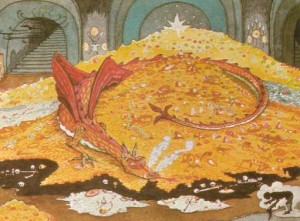
The Evolution of Smaug
by ArchedCory
I am sure many of you are familiar with the explanation Tolkien wrote in a letter to the ‘Observer’ in January 1938:
“The dragon bears a name – a pseudonym – the past tense of the primitive Germanic verb Smugan, to squeeze through a hole: a low philological jest.”
So that’s it, not a very exciting story.
However, what most people might not know: Smaug has not always been called Smaug! In the very first manuscript (of which merely six hand-written pages exist), back in a time when the wizard was called Bladorthin, the chief dwarf Gandalf, and his grandfather Fimbulfambi, Smaug also had a different name, and it was Pryftan.
Apparently “pryf” is the Welsh word for “vermin” and “tan” means “fire”, so that name – as most of his others – was possibly also very well considered. However Pryftan didn’t survive very long. Already in the second manuscript, written down only shortly after the first, Tolkien struck out Pryftan and wrote Smaug instead. Why he changed the name, we will never know.
Age
From the very beginning up until the published book, the text read that dragons live “practically for ever, unless they are killed.” When Tolkien in 1960 attempted to re-write The Hobbit in a more mature way to better fit the tone of the Lord of the Rings (he never made it past Rivendell), this line was changed to “five thousand years maybe”, and soon to “a thousand years maybe”.
I suppose Tolkien was always aware they are mortal, just within a much longer time range than men, or even dwarves. Since he was writing a children’s book at first it was convenient to write “practically forever,” as 1000 years are already hard to grasp for a human, especially a child. It is interesting he lowered the number from 5000 years, which probably sounded too exaggerated, even for a dragon.


